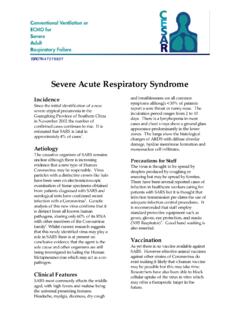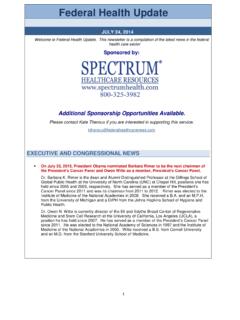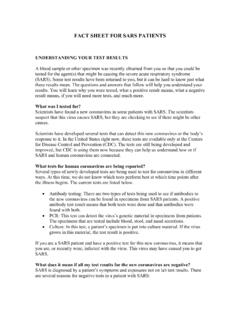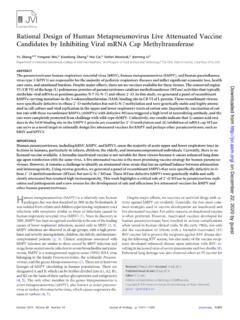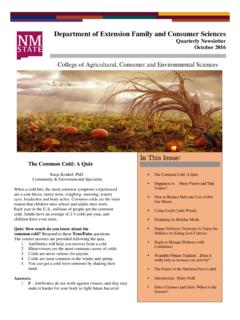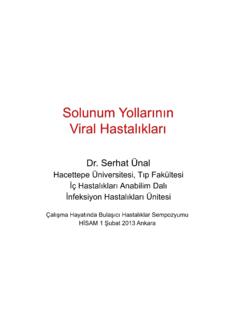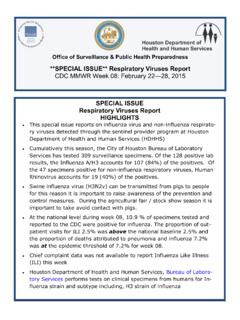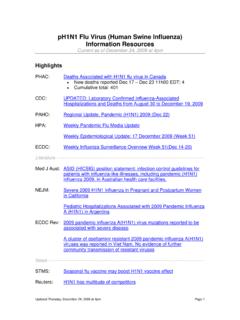Transcription of Human Metapneumovirus Fact Sheet - michigan.gov
1 April 17, 2012 1 Human Metapneumovirus fact Sheet michigan Department of Community Health Discovered in 2001, Human Metapneumovirus (hMPV) is an enveloped Paramyxoviridae virus that is found hMPV causes respiratory infection in humans of all ages and is spread by contact with respiratory secretions of infected persons or contaminated objects/surfaces. The incubation and contagious periods are not well defined but are probably similar to those of respiratory syncytial virus. Clinical Presentation hMPV infections range from mild respiratory illness to severe cough, bronchiolitis, pneumonia and exacerbation of preexisting respiratory conditions. The presentation is similar to respiratory syncytial virus infection and may also include high fever, myalgia, rhinorrhea, dyspnea, tachypnea, and wheezing.
2 Severe cases may require hospitalization, oxygen, and mechanical ,2 No antiviral medications specific to hMPV are currently available; treatment is symptomatic. Epidemiology hMPV is detected throughout the year, with peak activity often in late winter to early Most individuals are infected by age 5 years but reinfection is In children, hMPV has been detected in 1-5% of upper respiratory infections and 12% of lower respiratory tract ,4 Although hMPV infection occurs in adults, the incidence is not well described. High-risk adults include the elderly, immunocompromised, transplant recipients and those with ,6,7,8,9 hMPV can cause respiratory outbreaks in a variety of settings. Laboratory Testing Since hMPV symptoms are similar to those of other Human respiratory viruses, laboratory testing is required to diagnose hMPV.
3 The most common method is PCR testing of respiratory specimens, which is available at the MDCH Bureau of Laboratories for outbreaks and also at some clinical laboratories. Additional testing methods for hMPV include immunofluorescence, culture and serology. Prevention Steps to prevent hMPV infection are similar to those for other respiratory viruses and include: Cover your nose and mouth with a tissue when you cough or sneeze. If you don't have a tissue, cough or sneeze into your upper sleeve or elbow. Throw the tissue in the trash after use Wash your hands often with soap and water if available, or use an alcohol-based hand rub Avoid touching your eyes, nose and mouth Try to avoid close contact with sick people While sick, stay home and limit contact with others to keep from infecting them References 1.
4 Van den Hoogen BG, et al. A newly discovered Human pneumovirus isolated from young children with respiratory tract disease. Nat Med. Jun 2001; 7(6):719-24. 2. Wilkesmann A, et al. Human Metapneumovirus infections cause similar symptoms and clinical severity as respiratory syncytial virus infections. Eur J Pediatr. Mar 23 2006. 3. Williams JV, et al. The role of Human Metapneumovirus in upper respiratory tract infections in children: a 20-year experience. J Infect Dis. Feb 1 2006; 193(3):387-95. 4. Williams JV, et al. Human Metapneumovirus and lower respiratory tract disease in otherwise healthy infants and children. N Engl J Med. Jan 29 2004; 350(5):443-50. 5. Falsey AR, et al. Human Metapneumovirus infections in young and elderly adults. J Infect Dis. Mar 1 2003;187(5):785-90. 6. Williams JV, et al.
5 A prospective study comparing Human Metapneumovirus with other respiratory viruses in adults with hematologic malignancies and respiratory tract infections. J Infect Dis. Sep 15 2005;192(6):1061-5. 7. Englund JA, et al. Brief communication: fatal Human Metapneumovirus infection in stem-cell transplant recipients. Ann Intern Med. Mar 7 2006;144(5): 344-9. 8. Rohde G, et al. Relevance of Human Metapneumovirus in exacerbations of COPD. Respir Res. 2005;6:150. 9. McManus TE, et al. Respiratory viral infection in exacerbations of COPD. Respir Med. Nov 2008;102(11):1575-80. April 17, 2012 2 Human Metapneumovirus in Facility Outbreaks michigan Department of Community Health Outbreak Definition A suspect Human Metapneumovirus (hMPV) outbreak is defined as two or more cases of acute respiratory illness identified within 48 hours within a facility with at least two of the following symptoms: fever, sore throat, hoarseness/difficulty swallowing, a new dry or productive cough, chills, runny nose/sneezing, nasal congestion, myalgia, malaise, headache, and decreased appetite.
6 Confirmation of hMPV as the causative agent of an outbreak requires at least one hMPV-positive laboratory result in a resident or staff member of the facility with compatible symptoms. Laboratory Confirmation The MDCH Bureau of Laboratories offers hMPV testing of respiratory specimens for outbreaks; testing is highly encouraged. Approval for MDCH testing must be obtained from the MDCH Division of Communicable Disease at (517) 335-8165. A few clinical labs also provide PCR testing for hMPV. Action Steps 1. Reporting/Surveillance A facility must notify their local health department (LHD) immediately of any respiratory outbreak The LHD must notify MDCH by phone (517) 335-8165 or a faxed outbreak report (517) 335-8263 The facility should develop a plan for surveillance and testing in coordination with the LHD 2.
7 Infection Control Standard precautions should be observed for ALL healthcare encounters Acute care facilities In addition to standard precautions, implement contact precautions, for the duration of illness, as stated in the 2007 Guideline for Isolation Precautions: Preventing Transmission of Infectious Agents in Healthcare Settings guide ( ) Encourage patients, staff and visitors to use general prevention measures as listed on page 1 Long term care and assisted living facilities In addition to standard precautions, highly consider implementing contact precautions for the duration of illness: ( ) Encourage residents, staff and visitors to use general prevention measures as listed on page 1 Cohort and/or isolate ill residents as feasible Restrict ill staff from patient care.
8 Restrict movement of other staff between wards Implement facility policy for restriction of ill visitors; consider restriction of all visitors Implement the facility policy for limiting or deferring new admissions Schools/daycares/camps Encourage students, parents, and staff to use general prevention measures as listed on page 1 Encourage routine surface cleaning through education, policy, and the provision of supplies Follow your facility s standard waste handling procedures, which may include wearing gloves Separate sick students and staff from others until they can be picked up to go home Questions? Please call the michigan Department of Community Health at (517) 335-8165











